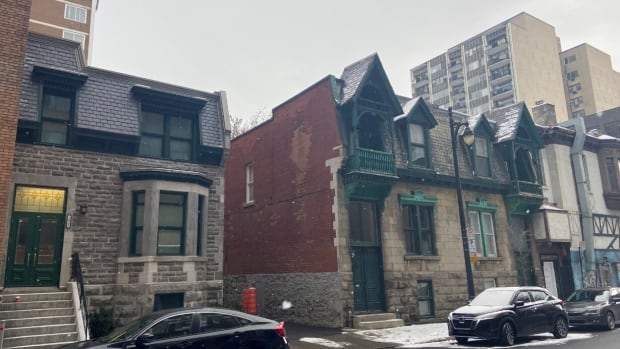Unlike its neighbours, the house at 1423 Towers St. in downtown Montreal seems to have withstood the test of time. While its stone Victorian walls appear unchanged, the building itself is hiding a secret: it’s not a house at all — at least, not anymore.
For years, Montreal’s transit authority has been discreetly building a sprawling ventilation system within — and below — the abandoned building. Behind its snow-crusted front steps lie the hidden depths of the city’s Metro system.
The STM said it chose the old house for its ventilation station because land is scarce in the downtown core, especially near the Metro’s Green line, under de Maisonneuve Boulevard.
Martin Allard, an architect with the Société de transport de Montréal (STM), said the house was built as upper-middle class Montrealers moved closer to the city’s Golden Square Mile.
“It was important for us to preserve it, that spirit, of what it was like in that era.”
Rebuilt brick by brick
Allard explained that the building had been empty for decades, often used by squatters and in disrepair. The wooden structure wasn’t salvageable and little of the original interior was left intact behind the stone walls, he said.
To make sure it was rebuilt properly, the STM scanned the front of the building, numbering each stone and marking its place on the facade so it could be rebuilt exactly as it was. The outdoor woodwork was rotten, but a craftsman was able to make identical replacements, Allard said.
The original stained glass window above the door was restored. Allard said they had to dig through 364 layers of paint to find the original colour of the wood frame — it was green.

Finally, to perfect the illusion, lighting was installed in the front hall, so the home looks inhabited.
“It looks believable,” Allard said. “People even leave flyers on the porch, and we have to make sure to remove them once in a while!”
But the illusion ends at the front door. Pushing it open, one is met with a gaping concrete stairwell — one that descends 18 metres underground, into the tunnels of the Metro system.
Up above, an opening — disguised in the original’s house’s roof — lets sunshine and snowflakes tumble in.
Keeping it quiet
“To the left is the tunnel that will go to the Metro,” explained Éric Perreault, a project director with the STM. At the bottom of the tunnel are huge fans and silencers, recently installed.
Perreault said there are three functions of a ventilation station: to bring in fresh air in, especially on hot summer days; to exhaust the fumes from diesel equipment used at night; and evacuate smoke in case of a fire.
The network’s first ventilation stations, made in the 1960s, have to be rebuilt to increase their capacity, explained Perreault. The Towers substation can move almost three times more air than the one it’s replacing.

But the new ventilation stations also have to meet modern noise requirements. The sound of the fans can’t exceed 50 decibels in the nearest bedroom, Perreault said.
“The fans generate 115 to 120 decibels of noise and we have to reduce it to 50. What is 50 decibels? It’s the equivalent of a [high-end] dishwasher that you have in your kitchen that you don’t hear,” he said.
To reduce the noise, silencers were placed in the tunnel. Sound-dampening panels, filled with insulating foam, are spaced apart on either side of the fans; two people on either end can’t hear each other, even when yelling.
Aside from not disturbing the neighbours, the silencers also ensure that the fans don’t overpower the loudspeakers, in case of an emergency announcement.
Years-long projects
Perreault said the STM has been working to rebuild its ventilation stations since the early 2000s. So far, 11 new stations have been completed, with six still under construction. By 2026, nearly $640 will have been invested in the STM’s ventilation network, Perreault said.
Each station takes about three to four years, to account for the quality of life of residents. One project, near Papineau Avenue, has been under construction since 2018. The problem? There are rocks that need to be micro-blasted with explosives, Perreault explained.
“We aren’t in a quarry, we are in downtown Montreal with buildings all around,” he said. “So we have to go slowly, so we aren’t disturbing people, the residents who live around the construction site.
The Papineau station was also marred by a fire that caused major damage, but Perreault said the site should be operational by 2023.



